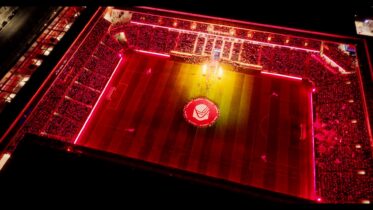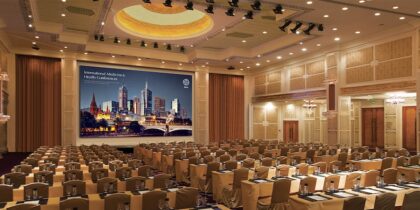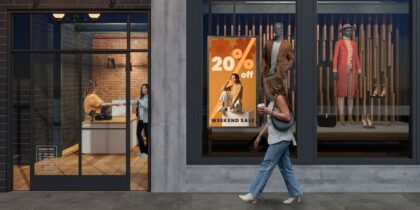The annual InfoComm trade show, taking place June 4–10 at the Las Vegas Convention Center, is one of the largest professional audio visual trade shows in the world, eclipsed only by the Integrated Systems Europe show each February in Amsterdam.
InfoComm is a gathering point for the pro audio visual community, pulling some 40,000 people from North America and more than 100 other countries around the world. They show up because they want to see what’s new and important to their businesses and networks, and tap into the vast education program that starts days ahead of the exhibit hall’s opening.
The trade show has almost 1,000 vendors in 2016, so it’s easy to get lost or run out of time. Here are some navigation tips.
Plan Ahead With a Floor Map
In some ways, InfoComm is an aggregate of several shows and industries. There are big chunks of space devoted to areas that are really interesting, but may have little relevance to your business or needs, so it’s important to know where you’re going.
Do Some Research
If you have specific areas of interest, do some advance research to find out who the important players are and what they offer. Build a checklist and plan your time accordingly, instead of just wandering aisles.
Bring Your Nerd(s)
If you’re technically-oriented, you’ll be in your element at this show. If not, bring someone along who can provide a helpful translation of tech jargon so you can stay clear and focused on what matters.
Drink Water and Plan Your Transportation Ahead of Time
The Las Vegas Convention Center is air-conditioned, of course, but getting there — even a short walk from a hotel — can be an adventure in June, where temperatures can reach up to 110 degrees Fahrenheit.
What to See
Much of the attention at InfoComm will be on fast-emerging technologies that are changing the game in digital signage. Here are four must-sees:
Direct View LED
The traditional LED displays are changing. It used to be that LED displays only looked good from a distance far enough away that eyes couldn’t see the gaps between the LEDs. But in the last three years, manufacturers have started producing LED displays that group individual LEDs much more closely together. While outdoor billboards have gaps between LEDs — known as the pixel pitch — of 10 or more millimeters, new indoor LED products have gaps as tight as just 1 mm. That means that while a 10-mm pixel pitch outdoor billboard looks best from a distance of 100 feet or more, a 1.5-mm pixel pitch Samsung indoor LED display looks rich and crisp from just 10 feet away.
Indoor LED is sometimes referred to as direct view LED because today’s LCDs are almost all illuminated inside by LED lighting. Direct view means that instead of looking at white light generated by LEDs, viewers are looking directly at the LEDs themselves.
Beyond advertising and media applications, Samsung will be talking at InfoComm about how its indoor LED signage represents a higher-performing and lower-maintenance alternative to legacy classroom and boardroom technologies like projection systems.
Daylight-Readable Displays
LEDs have not only revolutionized the indoor display business, they’re also having their moment — literally — in the sun. Samsung sees a growing market demand for displays that can be used in direct sunlight, outdoors in environmentally-sealed and cooled enclosures, and inside shop and building windows.
Daylight displays are becoming much more viable as fluorescent backlights have been supplanted by cooler-running, more energy-efficient LEDs that have the power to produce visuals that cut through the glare of direct, mid-afternoon sun. Samsung has developed a 2,500 nit, daylight-readable OH55D display series designed for ready integration by companies that build and deliver enclosures for quick service restaurant drive-thru lanes. Samsung’s setup allows companies to minimize in-house R&D work by instead installing ready-to-go displays into their own enclosure designs, or retrofitting existing print-based pre-sell and menu order boards.
Samsung also has a related OM55D series designed to sit inside street-level windows.
Video Walls
Steady engineering advancements have reduced video wall bezels (or frames) for displays to gaps so minute that the seams between them all but vanish. Samsung now has bezel gap technology (the space from bezel to bezel) that’s just 1.4 mm, meaning multiple large-format displays can appear as one very large screen with almost no discernible seams.
What these new super-slim bezels offer is the opportunity to build clusters of vibrant displays into the architecture of private and public spaces and bring them alive. Without noticeable grid lines between the panels, the visuals look amazing.
System on Chip
Samsung introduced the pro-AV world to the concept of digital signage displays that ship with the media player already embedded inside, using what’s known as system on chip (or SoC) technology. These embedded displays — now in a third generation — are being used all over the world by everyone from small businesses to large enterprises to run signage applications cost effectively. Using Smart Signage saves on initial costs both in hardware and the time needed to get started.
This year’s conference will educate and inspire attendees with cutting-edge audio and visual solutions, and Samsung will have a spectacular booth, full of its latest display technologies and staffed by a top business and technical team.
Find the right digital signage for your business by browsing our diverse selection of indoor and outdoor displays.








